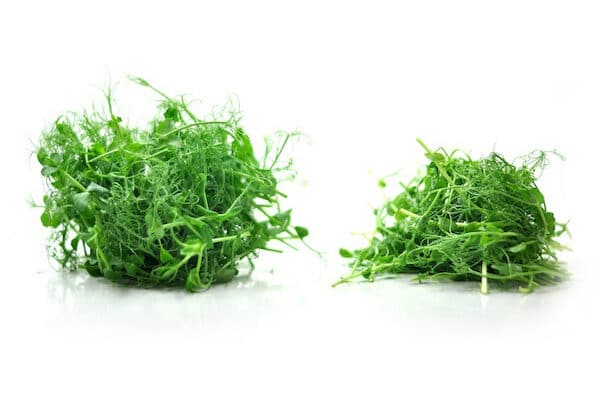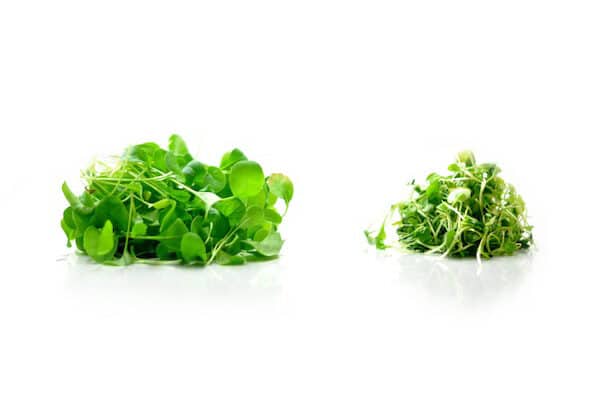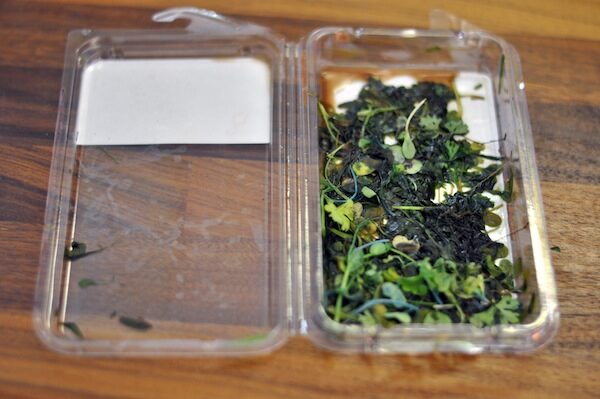
26 Sep How Do Urban Cultivator-Grown Microgreens Compare to Store-Bought Microgreens?
Time and again, we’ve talked about how microgreens, vegetables, herbs, and flowers grown in an Urban Cultivator blow store-bought produce right out of the water, but how do they really compare?
So, we decided to conduct an experiment to show you.
We went to a local supermarket chain that specializes in natural and organic foods and picked up some produce to check out the competition. There wasn’t a whole lot available in terms of selection, so we purchased arugula microgreens, pea shoot microgreens, and a box of mixed micros.
The three small boxes cost just under $20.
Here’s what we found when we put store-bought microgreens next to with those purchased at a grocery store.

Urban Cultivator peashoot microgreens vs. store-bought

Above on the left are pea shoot micros grown in an Urban Cultivator Commercial unit. That lush bunch of pea shoot micros only took less than 10 days to grow, and were cut moments before its close-up.
The store-bought pea shoot micros cost $6. Their leaves are much small than those grown in the Urban Cultivator. In all honesty, they look quite sad.
We weighed the Cultivator-grown greens to match the weight of the store-bought pea shoot micros (seen on the right). Evidently, the store-bought micros are limper and lifeless when compared to the pile grown in the Cultivator.

Urban Cultivator arugula microgreens vs. store-bought

The arugula microgreens took roughly three weeks to grow in a Cultivator unit. Similar to the pea shoot micros, the pile of store-bought arugula also looks wilted and lifeless, though less limp than the store-bought pea shoots.
In order to minimize waste, we made two salads—one with the Urban Cultivator-grown micros, and the other with store-bought micros. We kept it super simple so that the natural flavours in the microgreens could come through.
We found that the salad with store-bought microgreens were relatively flavorless. They lacked crunch, and when compared to the Urban Cultivator-grown micros, they were also less vibrant.

We had also purchased a mixed microgreen pack, but, well… this is what happened:

Those wilted greens had been purchased for less than 24 hours and were already rotting. This is $6 worth of microgreens gone to waste. Obviously, whatever blend that could be produced by an Urban Cultivator unit would blow these ones out of the water in terms of flavour.

That last image is a sight that’s all too familiar. Microgreens are high-maintenance, demanding that you consume them immediately. But sometimes, that’s not the most convenient thing; many people do not have the luxury to purchase groceries right before they prepare their meal.
The hidden text of store-bought microgreens and herbs is that the nutritional content diminishes exponentially after it’s harvested. Of course, you want your food to be fresh, so growing your own is also another option.
But with weather constraints and potential muddy messes, growing your own microgreens can be daunting task if you don’t have a green thumb.
We can repeat ourselves over and over—that growing with an Urban Cultivator is the best thing you could do for yourself and your loved ones when it comes to fresh food—but those photos speak for themselves.
With an Urban Cultivator indoor garden unit, you are able to grow up to 35 varieties of microgreens, herbs, flowers, and vegetables. You’re also able to harvest mere seconds before you serve the food, meaning that you are serving the most nutrient-packed food possible.
Not only that, but it’ll also taste much, much better.
Growing in an Urban Cultivator unit will also save you a bundle of money. Arugula seeds for the Cultivator only costs $7.99, and can grow much more than however much is in those small container from the grocery stores.
Lastly, you’ll also eliminate your carbon footprint by cutting out the middleman. Your greens have to go a long way, from the farm or wherever they’re grown, to your table.
When eating greens grown from an Urban Cultivator, you can really feel good about your food.

What do you do when your store-bot micros rot? Have you also experienced this? Tell us about your awful experiences with store-bought greens in the comments section!

